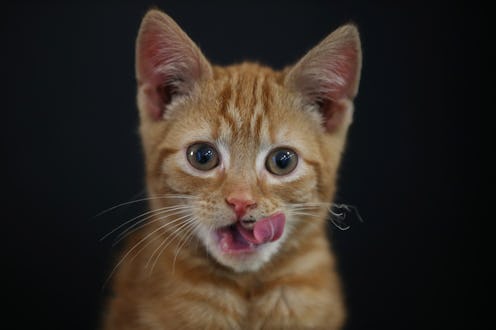
If you're a new pet parent to a feline fur baby, you'll want to make sure that Fluffy or Whiskers is healthy and happy. However, if this is your first cat you might wonder, is my cat eating enough? It's a common question among new pet parents, and there are ways to make sure your furry-feline friend is getting proper nutrition. Cats, unlike dogs, can be pretty finicky when it comes to their food, and if they don't like it they often won't eat it, even if they're hungry. This is why it's important to strike a balance between your cat's nutritional needs and its preferences. Because, no matter what their humans think, the cats are really in charge.
"When you bring a new cat home, it’s important to continue to feed her the same amount of the same food on the same schedule that’s she’s been accustomed to, then gradually migrate to your own food and schedule," the website Catster advised. "Cats are very sensitive to change, and a new cat will be dealing with a lot of new-environment stress, so keeping the food and schedule consistent will ease her transition and keep intestinal upset at bay."
With cats, it's also totally fine to let them graze, which means you can leave a bowl of food out all day — just don't keep refilling it all day. You'll also want to make sure your cat has access to fresh water at all times. Additionally, it's important to note that despite what you've seen in cartoons, cats actually don't process cow's milk well, so you should never give kitty dairy.
While you might be concerned your cat isn't eating enough, there is such a thing as feeding Fluffy too much. Indoor cats "are more sedentary, as compared to the days when they were barn cats and more active," Linda P. Case, MS, author of The Cat: Its Behavior, Nutrition, and Health told WebMD. "They're little couch potatoes now, their nutrition needs are much lower, so it's easy to overfeed them."
The first thing to do when you take your kitty in for its initial check up is to ask your veterinarian how much food your cats needs. Kittens need different types of food, and different amounts of food, than adult cats. And, feeding an adult cat a nutrient-rich kitten food could result in Fluffy becoming overweight. What's more, it's a good idea to feed your cat both wet and dry food because cats are less likely to drink water than their canine counterparts.
"We know that a cat’s sensitivity to thirst is blunted compared to a dog," Susan G. Wynn, DVM, a veterinary nutritionist in Georgia and author of Manual of Natural Veterinary Medicine, told WebMD. "They don't voluntarily drink water like a dog would." And, when cats don't drink enough water, they can develop urinary tract infections, just like their human parents. Feeding your cat a high-quality wet food ensures that kitty is getting water in its meal.
You should also feed Fluffy a diet that's high in protein, and make sure it's a food formulated for cats because felines have different dietary needs than other domestic animals like dogs. As far as how much to feed your kitty, there's a calculation you can use to determine how much food to give your cat. "According to the Animal Medical Center in New York, a healthy, active 8-pound adult cat requires about 30 calories per pound per day. So, the average 8-pound cat requires about 240 calories per day," Catster advised.
If you're following all of the recommended guidelines, but still you're concerned that Fluffy isn't getting enough calories, Catster recommended examining your cat's back. If you can see Fluffy's backbones or ribs through its coat, take your kitty to the vet. The problem could be as simple as changing your cat's diet. If the food is too rich for your cat, it might be going straight into the litter box. Once you find a feeding routine, portion size, and brand that works for you and Fluffy, stick to it. Because, cats don't like change, and neither do their digestive systems. #TheMoreYouKnow.